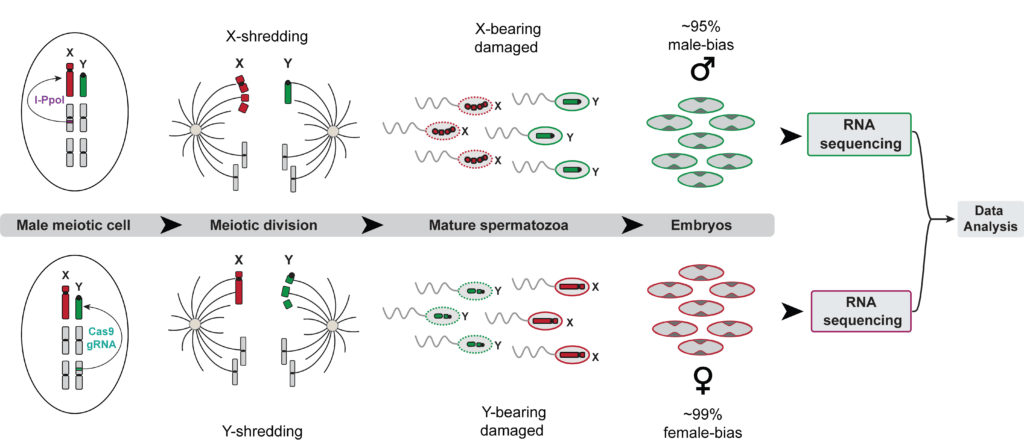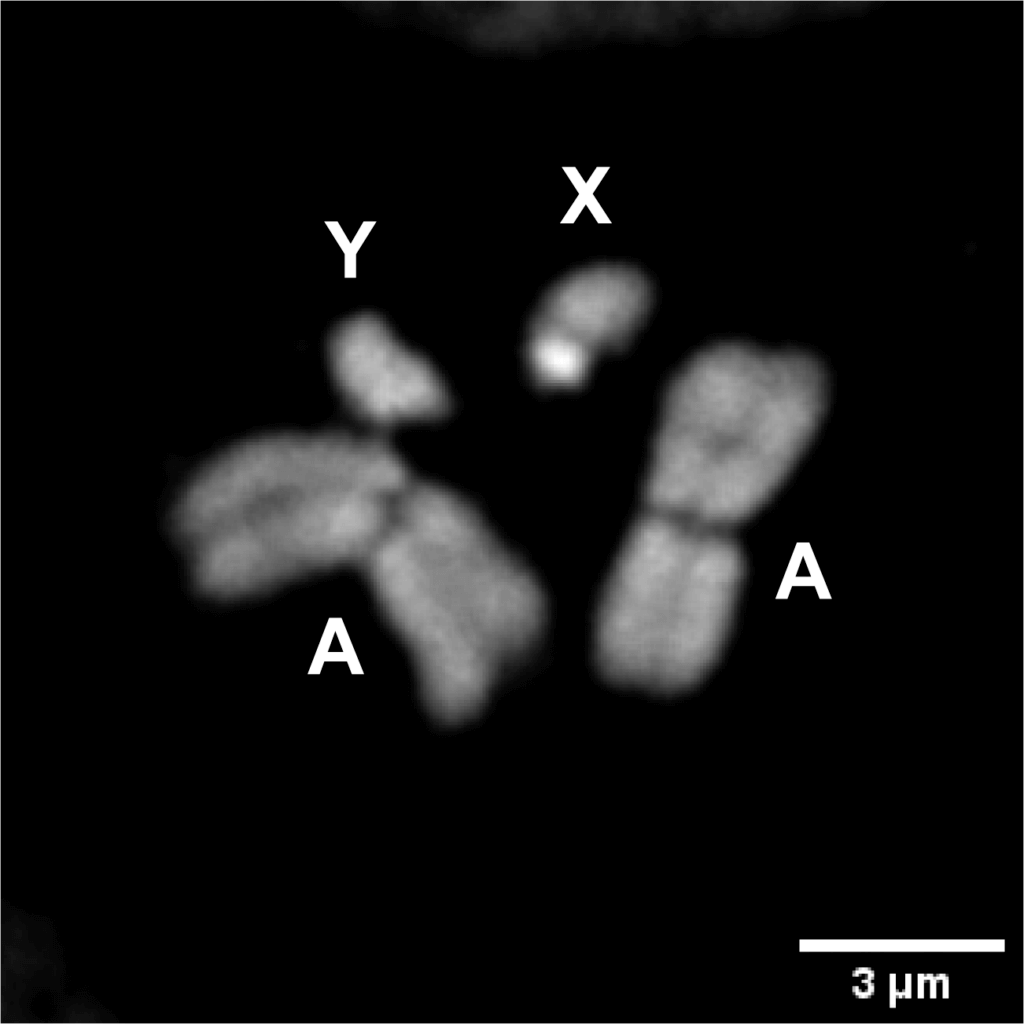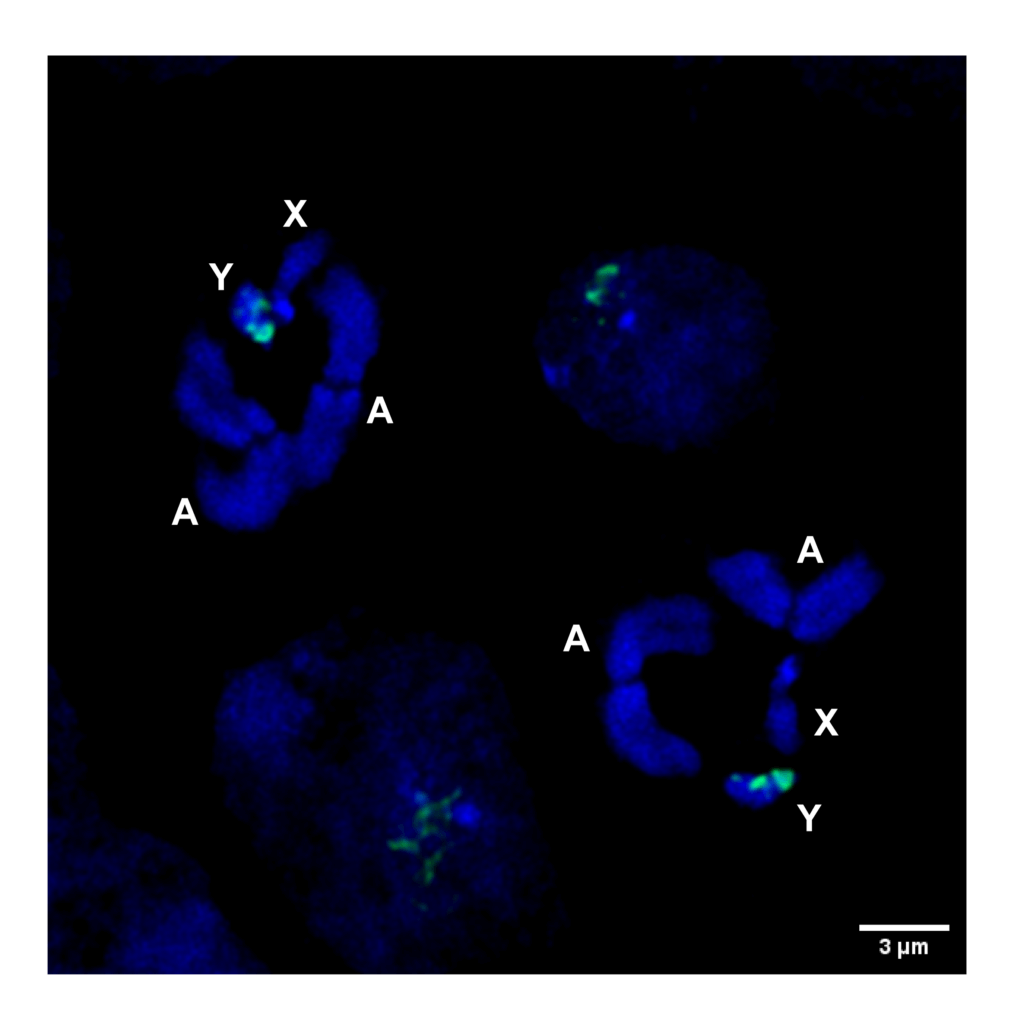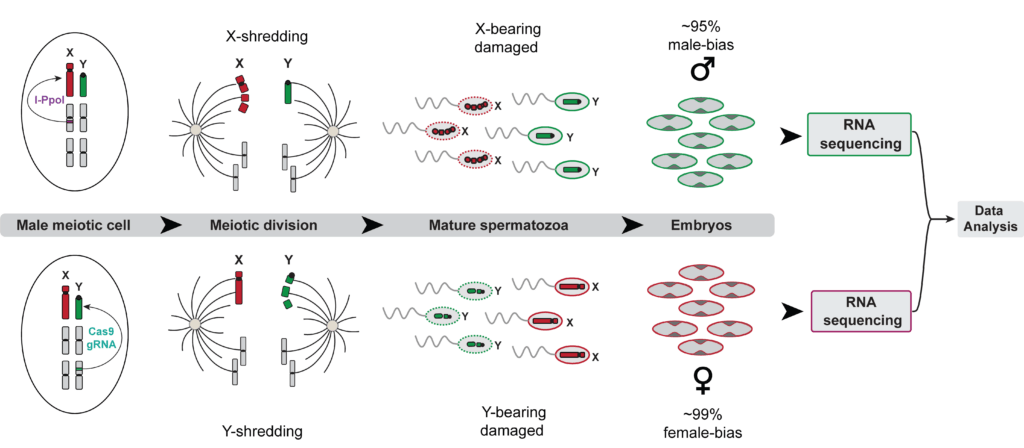Y chromosome shredding in Anopheles gambiae: a new genetic sexing strain reveals novel insight into the biology of synthetic sex ratio distorters


There are naturally occurring genetic elements, known as sex ratio meiotic drive, which can influence the sex ratio of offspring, favouring either the male or female sex. These elements have been reported in many different animal groups, including insects, mammals and plants.
On top of being fascinating biological phenomena, the ability of these genetic elements to control the sex ratio could be a powerful tool in developing novel vector control strategies to reduce the spread of diseases. In the case of the main malaria vector, Anopheles gambiae, it could be used in vector control strategies to reduce the number of infected females which carry the malaria parasite.
If engineered in the lab, such a system can be used to reduce the number of females in the offspring, allowing the reduction of the population of a target species.
A few years ago, a synthetic sex ratio distorter system was engineered in Anopheles gambiae by the Crisanti Lab. The study showed that reducing the number of females by altering the sex ratio in the offspring towards males can lead to the collapse of a mosquito population in laboratory settings over a few generations. The strain, named “male bias” or “Ag(PMB)1”, is a powerful tool for vector control, and currently, preliminary studies are testing its efficacy in the field.
Before explaining our recent work, it is important to detail some features of Anopheles mosquito genetic and reproduction biology.
An. gambiae mosquito harbours a pair of sex chromosomes (XX and XY, similar to humans) and a pair of autosomes. When a mosquito inherits an XY chromosome pair from its parents, it will develop as a male. When a mosquito inherits a pair of XX chromosomes, it will develop as a female. Similar to humans, male mosquitoes are the sex that is responsible for providing X or Y-bearing sperm to the offspring. Following mosquito mating, sperm with X or Y chromosomes fertilise the female egg, leading to the generation of female (XX) or male (XY) individuals. Commonly, the probability of a Y-bearing sperm to fertilise the egg is the same as an X-bearing sperm, resulting in a 50% chance that an embryo inherits the X or Y chromosome. This results in the presence of the same amount of males and females in the mosquito offspring.

Fig1: Karyotype staining of An. gambiae male mosquito mitotic chromosomes Autosomes (A), X chromosome (X), Y chromosome (Y). [GK1]
Synthetic sex ratio distorter system (Ag(PMB)1 strain) works by altering this process, acting during the formation of X or Y-bearing sperm in the mosquito reproductive organ. More specifically, an endonuclease such as Ippol or Cas9, can be used to target a specific sex chromosome during male gametogenesis. The X- chromosome can be ‘shredded’, leading to the production of non-functional X-bearing sperm, while Y-bearing sperm are left intact and able to fertilise the eggs. This will increase the probability that Y-bearing sperm will fertilise the eggs, leading to a male-biased progeny.

Fig2: Molecular mechanism of X-shredding system. Targeting repetitive sequences on the mosquito X-chromosome leads to the formation of damaged X-bearing sperms. Therefore, only Y bearing sperm can fertilise the eggs, leading to a male bias in the progeny.
Now that we introduced the basic mechanisms of how synthetic sex ratio distorters work, we can introduce our latest study published in Plos Genetics[SM1].
Our research focused on investigating if it is possible to induce a female bias in the progeny by ‘shredding’ the Y chromosome during male gametogenesis in Anopheles gambiae.
Contrarily to the X chromosome, Anopheles Y chromosome sequence composition is poorly characterised, making it difficult to identify unique Y-linked target sites for chromosomal shredding. For this reason, we had to use two different approaches, combining in silico analyses and cytogenetics, to identify a unique target site on the Y chromosome.

Fig3: DNA FISH on An. gambiae mitotic chromosome obtained from male testis showing location of the target site used for Y chromosome shredding. A (Autosome), X (X chromosome), Y (Y chromosome). Green = Y-linked satellite, Blue =DAPI.
After the selection of the target site, we used CRISPR/Cas9 system to target repetitive sequences in the Y chromosome during male gametogenesis. After a few attempts, we found that mosquitoes harbouring our genetic construct were generating a high female-biased progeny (99%) with no reduction in their fitness, suggesting that our system was targeting the right amount of Y-linked sequence to induce Y chromosome shredding in the male testis.
Given that the cellular mechanisms involved in sex-ratio distortion induced by synthetic sex ratio distorter are largely unknown, we also investigated how the shredding of the Y chromosome was impacting the meiotic process of sperm selection using DNA Fluorescent In Situ Hybridization (FISH). FISH is a technique that allow to label with fluorescent probes a specific region in the chromosomes. [DM1] Surprisingly, we found that the high level of sex-ratio distortion observed was linked to the presence of a sperm selection process acting against defective sperm before fertilisation take place in the female spermatheca.
The outcome of this study enhances our understanding of the molecular and biological mechanisms behind synthetic sex-ratio distorters in Anopheles mosquitoes, which could inform the development of vector control strategies that target sex ratio also in other organisms. Finally, we present a genetic sexing strain able to produce mostly females, providing a valuable genetic tool for fundamental studies on this deadly vector.
This strain has the potential to be used, in combination with the X-shredder strain “male bias”,[DM2] as a pre-zygotic sexing system, enabling the production of male and female-biased embryo batches.

Fig 4: Pre-zygotic sexing system enable to collect high numbers of male and female-biased embryos to perform RNA sequencing experiments to investigate differences between gene expression of male and female embryos at an early stage of development.
This innovative sexing system allows diverse sequencing experiments, paving the way for a deeper understanding of male and female early-stage development in Anopheles gambiae, potentially contributing to improved malaria control strategies.
